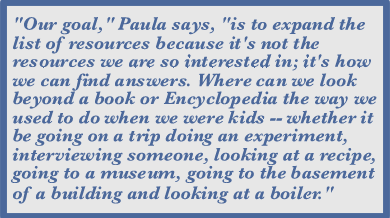Full Overview |
Paula Rogovin spends every year with her students investigating aspects of the community in which they have a particular interest. At the beginning of the year, she invites the students to tell her what they would like to learn more about. Once the students have generated a list of possible topics, she helps the students organize the questions into general categories like “transportation,”, “buildings,”, and “restaurants” and asks the students to vote for those that they would like to explore during the year (students can vote for more than one). Using the categories in which the students express the most interest, Paula launches investigations that often last two or three months. In many cases, she splits the class in half, and she and a student teacher each lead a different investigation, with each group sharing what they are learning with the rest of the class on a daily basis. Paula's current work takes place at a public elementary school in Manhattan.1
This website documents an experiment to learn how light bulbs work that half the class carried out as part of an investigation of “vehicles and transportation” that began in December of 2005 and continued through March of 2006. Paula initiated the investigation by asking the students to talk about what they already knew about vehicles and transportation. This discussion helped Paula learn about the students initial ideas (and occasionally about misinformation they might have). In addition, by asking students to tell her not only what they knew but how they knew it, she was able to discover that many students might have access to resources and people (like car mechanics or subway engineers) she could draw on to both engage parents and other members of the community and to help her support the students’ investigation. Then she asked the students to generate a list of questions (pdf) that they would like to learn more about as well as a list of ways they could find answers.

The investigation of vehicles began with a study of tires that progressed into an examination of rubber, a study of the rainforests where rubber comes from, and how rubber and tires are made. The class also investigated car windows and the production of glass and even safety glass before examining the lights of the car. Again, Paula began the investigation of lights by asking students what they already knew about lights and then asking them to generate a list of questions (pdf) about lights in vehicles and to think about how they might go about answering those questions. Initially, Paula simply asked students to observe and study a large light bulb and to imagine what light bulbs might “burn” in order to create light. The investigation continued with studies of the roles of Thomas Edison and Lewis Latimer (an African American who developed a carbon filament for lights) in the invention of the light bulb. This led to a discussion about how the lights could go on and off and some particular questions about lights in cars including how lights in cars could get electricity without a plug. These questions, in turn, led to a discussion of batteries and the day documented on this website in which the students experimented with light bulbs, wires and batteries. The students went on to explore how the lights in cars and traffic signals worked. Throughout, the class read books about vehicles, lights, Thomas Edison and Lewis Latimer; went on a field trip to a car repair shop, took a “neighborhood walk” to look at a traffic signal that was being repaired, and made a visit to the street to look at the Paula’s car; interviewed the school custodian (and a former car mechanic), produced a book about the work with lights, and created a poster/collage that had photos of Paula and her research group in a car – with working headlights.